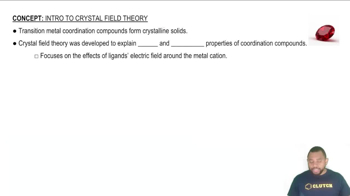Intro to Crystal Field Theory definitions Flashcards
 Back
BackIntro to Crystal Field Theory definitions
1/15
Terms in this set (15)
- Crystal Field TheoryExplains colors and magnetic properties of transition metal coordination compounds by ligand-induced energy changes in metal d orbitals.
- LigandsMolecules or ions that create an electric field around metal cations, affecting the energy of metal d orbitals.
- Metal CationsPositively charged metal ions that interact with ligands, influencing the energy of their d orbitals.
- d OrbitalsFive orbitals in transition metals whose energy levels are affected by ligand interactions in coordination compounds.
- Octahedral ComplexesCoordination compounds where ligands are positioned on the axes, affecting dx2-y2 and dz2 orbitals most.
- Tetrahedral ComplexesCoordination compounds where ligands interact most with dxy, dyz, and dxz orbitals, increasing their energy.
- Electrostatic InteractionRepulsion between like charges of metal cation and ligand electrons, raising d orbital energy.
- Ligand Field TheoryAn extension of crystal field theory incorporating molecular orbital theory to explain ligand interactions.
- Energy LevelsThe relative energy of d orbitals in metal cations, altered by ligand interactions in coordination complexes.
- Complex GeometryThe spatial arrangement of ligands around a metal cation, crucial for determining d orbital interactions.
- Magnetic PropertiesCharacteristics of coordination compounds influenced by the arrangement and energy of d orbitals.
- ColorA property of coordination compounds resulting from specific d orbital energy transitions influenced by ligands.
- dx2-y2 OrbitalA d orbital in octahedral complexes with significant ligand interaction along the x and y axes.
- dz2 OrbitalA d orbital in octahedral complexes with significant ligand interaction along the z axis.
- dxy OrbitalA d orbital in tetrahedral complexes with significant ligand interaction between the axes.



